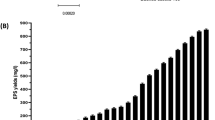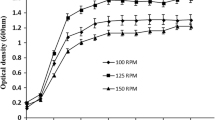Abstract
A linear glucan was produced by Lactobacillus sake L-7 isolated from homemade sausage. Cultivation of the strain in Man–Rogosa–Sharpe (MRS) medium containing 50 g/L sucrose yielded 5.3 g/L of purified exopolysaccharide (EPS). The EPS was characterized by gas chromatography (GC), Fourier-transform infrared (FT-IR) spectroscopy, high-performance size-exclusion chromatography (HPSEC), nuclear magnetic resonance (NMR) spectroscopy, and scanning electron microscopy (SEM). The monosaccharide composition of the EPS was glucose, and its molecular weight was 1 × 107 Da. The FT-IR and NMR spectra revealed that the L-7 EPS was a linear glucan with α-(1 → 6) glucosidic bonds. SEM images of the dried EPS revealed a hollow tubular structure. The water solubility index and water holding capacity of L-7 EPS were 96 and 272%, respectively. The results of hydrolysis indicated that L-7 EPS was not susceptible to hydrolysis by physiological barriers and can be used as a soluble dietary fiber with health benefits. All these characteristics suggest that L-7 EPS might have potential applications in the food, cosmetic, and pharmaceutical industries.






Similar content being viewed by others
References
Ahmed Z, Wang YP, Anjum N et al (2013) Characterization of exopolysaccharide produced by Lactobacillus kefiranofaciens ZW3 isolated from Tibet kefir—Part II. Food Hydrocoll 30(1):343–350
Sathiyanaryanan G, Dineshkumar K, Yang YH (2017) Microbial exopolysaccharide-mediated synthesis and stabilization of metal nanoparticles. Crit Rev Microbiol 43(6):731–752
Cui JD, Zhang BZ (2011) Comparison of culture methods on exopolysaccharide production in the submerged culture of Cordyceps militaris and process optimization. Lett Appl Microbiol 52(2):123–128
Ibarburu I, Puertas AI, Berregi I et al (2015) Production and partial characterization of exopolysaccharides produced by two Lactobacillus suebicus strains isolated from cider. Int J Food Microbiol 214:54–62
Bounaix MS, Gabriel V, Robert H et al (2010) Characterization of glucan-producing Leuconostoc strains isolated from sourdough. Int J Food Microbiol 144(1):1–9
Du RP, Xing HW, Zhou ZJ et al (2017) Isolation, characterisation, and fermentation optimisation of glucansucrase producing Leuconostoc mesenteroides DRP105 from sauerkraut with improved preservation stability. Int J Food Sci Technol 52(12):2522–2530
Cui JD, Qiu JQ (2012) Production of extracellular water insoluble polysaccharide from Pseudomonas sp. J Agric Food Chem 60(19):4865–4871
Baruah R, Maina NH, Katina K et al (2017) Functional food applications of dextran from Weissella cibaria RBA12 from pummelo (Citrus maxima). Int J Food Microbiol 242:124–131
Schmid J (2018) Recent insights in microbial exopolysaccharide biosynthesis and engineering strategies. Curr Opin Biotechnol 53:130–136
Zarour K, Llamas MG, Prieto A et al (2017) Rheology and bioactivity of high molecular weight dextrans synthesised by lactic acid bacteria. Carbohydr Polym 174:646–657
Kanmani P, Satish KR, Yuvaraj N et al (2011) Production and purification of a novel exopolysaccharide from lactic acid bacterium Streptococcus phocae PI80 and its functional characteristics activity in vitro. Bioresour Technol 102(7):4827–4833
Maina NH, Tenkanen M, Maaheimo H et al (2008) NMR spectroscopic analysis of exopolysaccharides produced by Leuconostoc citreum and Weissella confusa. Carbohydr Res 343(9):1446–1455
Leathers TD, Nunnally MS, Cote GL (2009) Modification of alternan by dextranase. Biotechnol Lett 31(2):289–293
Yuliani E, Imai T, Teeka J et al (2011) Exopolysaccharide production from sweet potato-shochu distillery wastewater by Lactobacillus sakei CY1. Biotechnol Biotechnol Equip 25(2):2329–2333
Robijn GW, Van den Berg DJC, Haas H et al (1995) Determination of the structure of the exopolysaccharide produced by Lactobacillus sake 0‒1. Carbohydr Res 276(1):117–136
Nácher-Vázquez M, Ballesteros N, Canales Á et al (2015) Dextrans produced by lactic acid bacteria exhibit antiviral and immunomodulatory activity against salmonid viruses. Carbohydr Polym 124:292–301
Yang YP, Peng Q, Guo YY et al (2015) Isolation and characterization of dextran produced by Leuconostoc citreum NM105 from manchurian sauerkraut. Carbohydr Polym 133:365–372
Ai LZ, Guo QB, Ding HH et al (2016) Structure characterization of exopolysaccharides from Lactobacillus casei LC2W from skim milk. Food Hydrocoll 56:134–143
Trabelsi I, Slima SB, Chaabane H et al (2015) Purification and characterization of a novel exopolysaccharides produced by Lactobacillus sp. Ca6. Int J Biol Macromol 74:541–546
Kavitake D, Devi PB, Singh SP et al (2016) Characterization of a novel galactan produced by Weissella confusa KR780676 from an acidic fermented food. Int J Biol Macromol 86:681–689
Saravanan C, Shetty PKH (2016) Isolation and characterization of exopolysaccharide from Leuconostoc lactis KC117496 isolated from idli batter. Int J Biol Macromol 90:100–106
Van den Berg DJC, Robijn GW, Janssen AC et al (1995) Production of a novel extracellular polysaccharide by Lactobacillus sake 0–1 and characterization of the polysaccharide. Appl Environ Microbiol 61(8):2840–2844
Wang J, Zhao X, Tian Z et al (2015) Characterization of an exopolysaccharide produced by Lactobacillus plantarum YW11 isolated from Tibet Kefir. Carbohydr Polym 125:16–25
Miao M, Bai AJ, Jiang B et al (2014) Characterisation of a novel water-soluble polysaccharide from Leuconostoc citreum SK24. 002. Food Hydrocoll 36:265–272
Ahmed RZ, Siddiqui K, Arman M et al (2012) Characterization of high molecular weight dextran produced by Weissella cibaria CMGDEX3. Carbohydr Polym 90(1):441–446
Du RP, Xing HW, Yang YP et al (2017) Optimization, purification and structural characterization of a dextran produced by L. mesenteroides isolated from Chinese sauerkraut. Carbohydr Polym 174:409–416
Bounaix MS, Gabriel V, Morel S et al (2009) Biodiversity of exopolysaccharides produced from sucrose by sourdough lactic acid bacteria. J Agric Food Chem 57(22):10889–10897
Freitas F, Alves VD, Reis MAM (2011) Advances in bacterial exopolysaccharides: from production to biotechnological applications. Trends Biotechnol 29(8):388–398
Lacaze G, Wick M, Cappelle S (2007) Emerging fermentation technologies: development of novel sourdoughs. Food Microbiol 24(2):155–160
Tian YT, Zhao YT, Zeng HL et al (2016) Structural characterization of a novel neutral polysaccharide from Lentinus giganteus and its antitumor activity through inducing apoptosis. Carbohydr Polym 154:231–240
Sun YX, Liu JC, Yang XD et al (2010) Purification, structural analysis and hydroxyl radical-scavenging capacity of a polysaccharide from the fruiting bodies of Russula virescens. Process Biochem 45(6):874–879
He YL, Ye M, Du ZZ et al (2014) Purification, characterization and promoting effect on wound healing of an exopolysaccharide from Lachnum YM405. Carbohydr Polym 105:169–176
Shao L, Wu ZJ, Zhang H et al (2014) Partial characterization and immunostimulatory activity of exopolysaccharides from Lactobacillus rhamnosus KF5. Carbohydr Polym 107:51–56
Seymour FR, Knapp RD, Bishop SH (1976) Determination of the structure of dextran by 13C nuclear magnetic resonance spectroscopy. Carbohydr Res 51(2):179–194
Uzochukwu S, Balogh E, Loefler RT et al (2001) Structural analysis by 13C-nuclear magnetic resonance spectroscopy of glucans elaborated by gum-producing bacteria isolated from palm wine. Food Chem 73(2):225–233
Purama RK, Goswami P, Khan AT et al (2009) Structural analysis and properties of dextran produced by Leuconostoc mesenteroides NRRL B-640. Carbohydr Polym 76(1):30–35
Li CC, Li W, Chen XH et al (2014) Microbiological, physicochemical and rheological properties of fermented soymilk produced with exopolysaccharide (EPS) producing lactic acid bacteria strains. LWT Food Sci Technol 57(2):477–485
Acknowledgements
The work was supported by National Science and Technology Support Program of China (No. 2015BAD16B01).
Author information
Authors and Affiliations
Corresponding author
Rights and permissions
About this article
Cite this article
Feng, F., Zhou, Q., Yang, Y. et al. Structural Characterization of Glucan Produced by Lactobacillus sake L-7 from Sausage. Trans. Tianjin Univ. 25, 78–84 (2019). https://doi.org/10.1007/s12209-018-0150-x
Received:
Revised:
Accepted:
Published:
Issue Date:
DOI: https://doi.org/10.1007/s12209-018-0150-x




